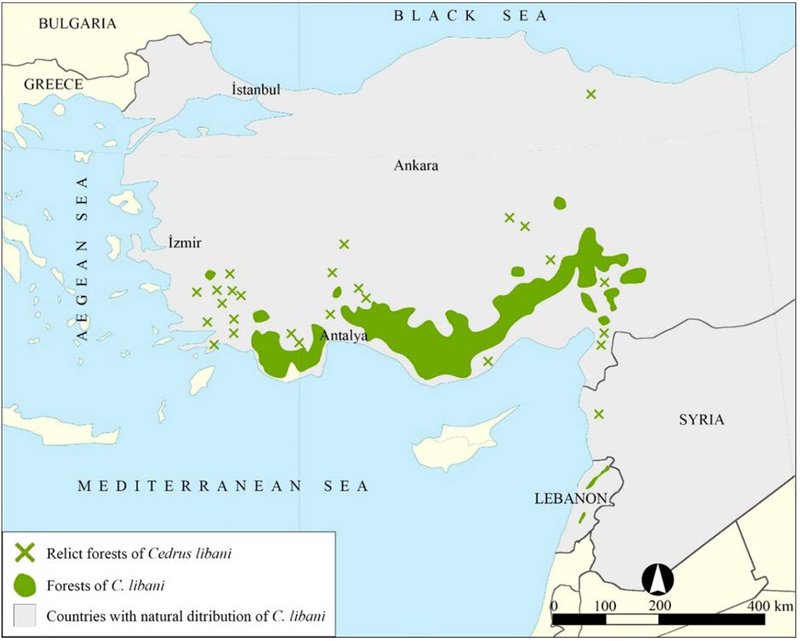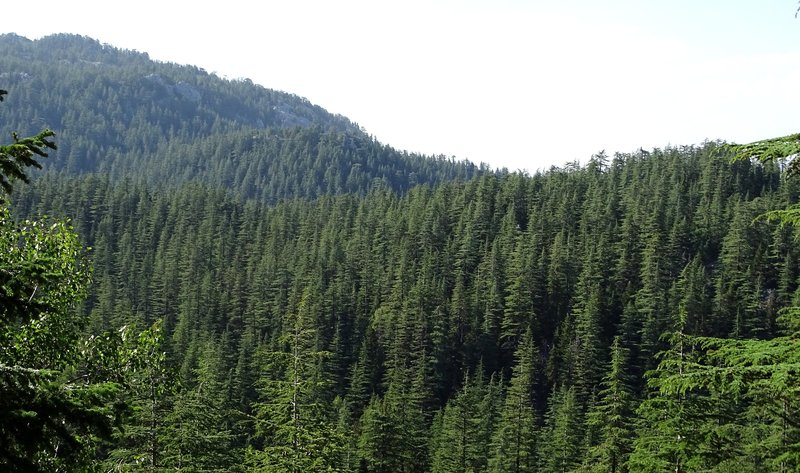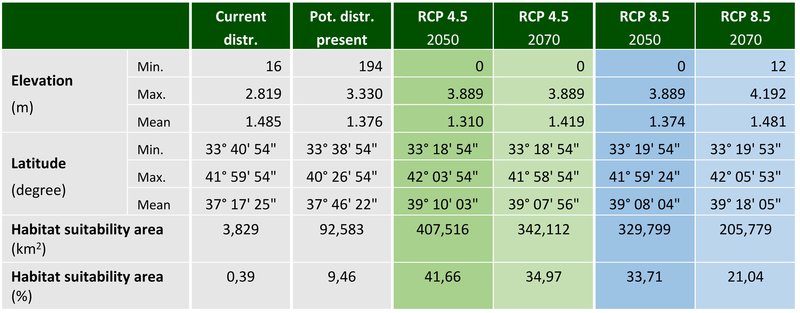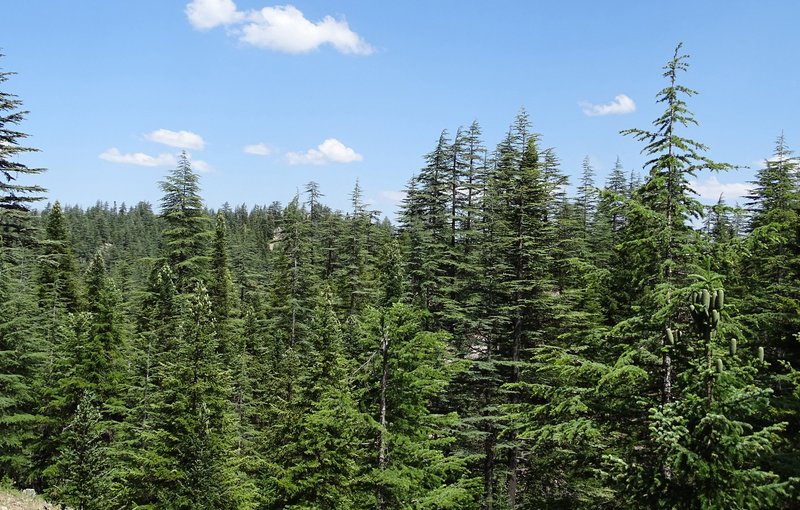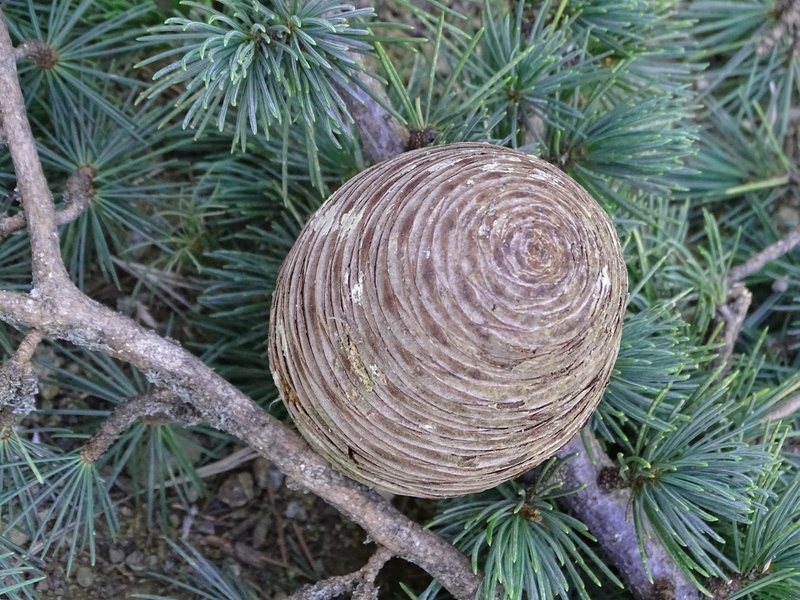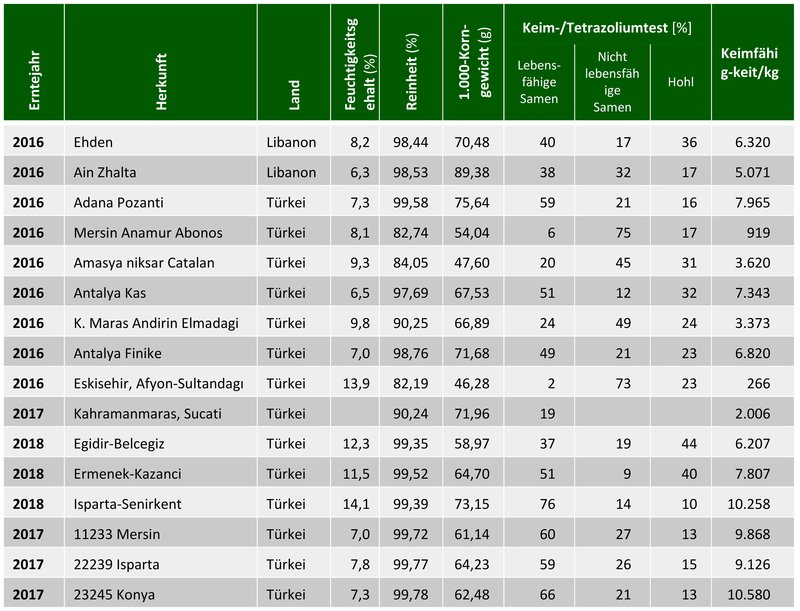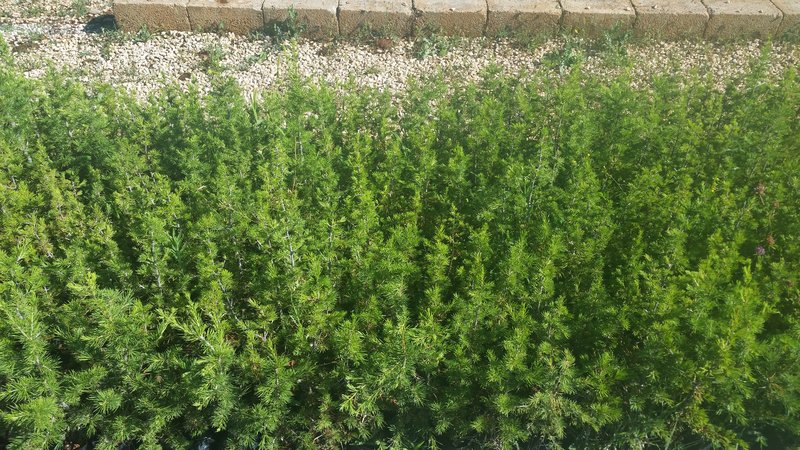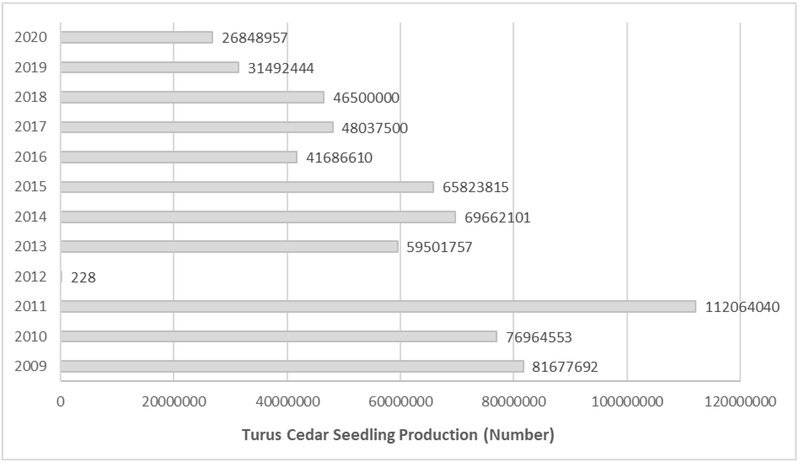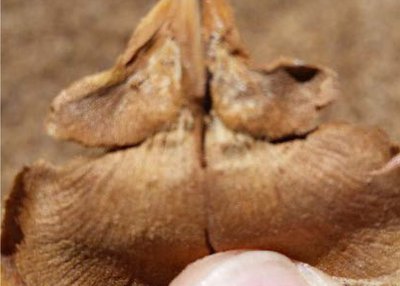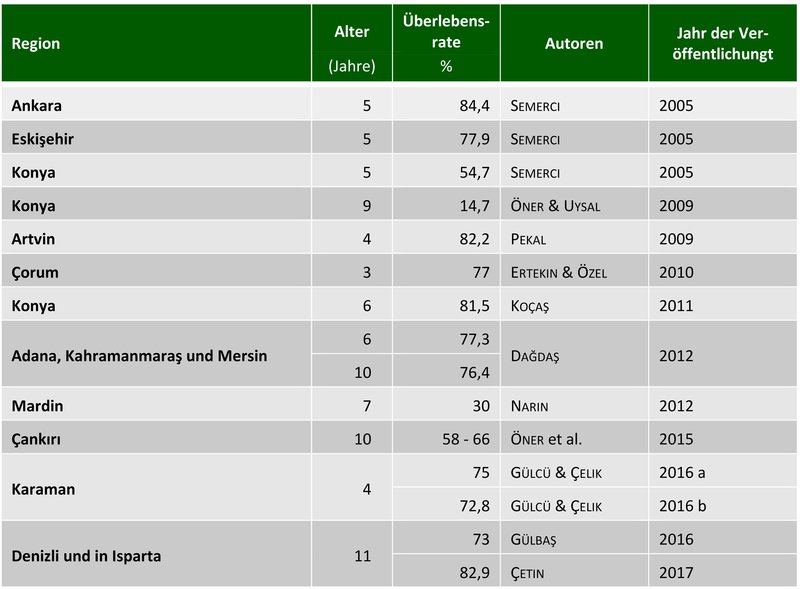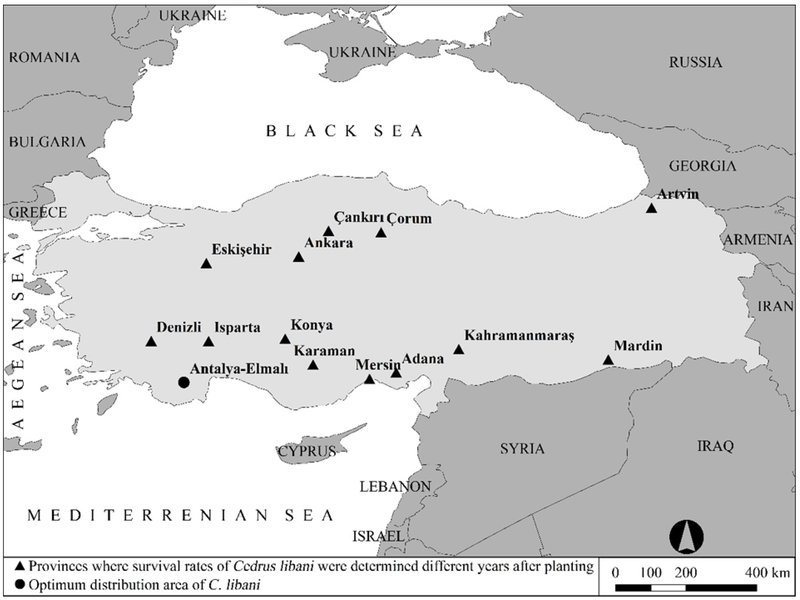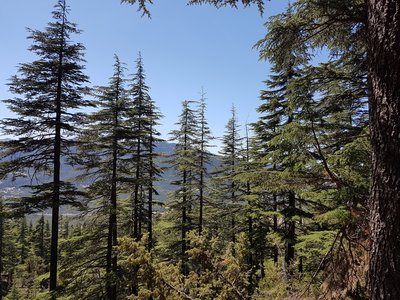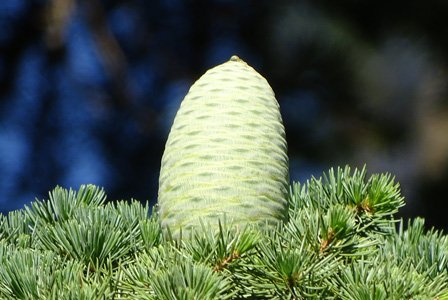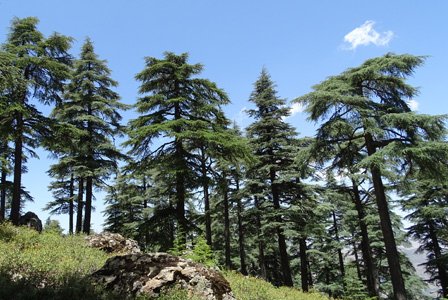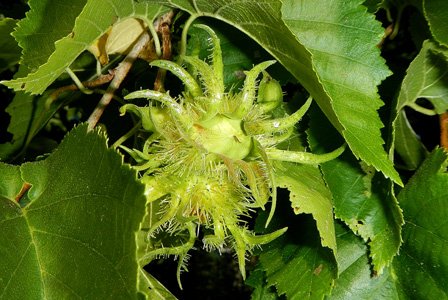This article should be of use to foresters and scientists in Turkey and central Europe who are working with this important and valuable tree species in the face of climate change.
It gives an overview of the seed harvesting stands, gene-conservation stands and seed orchards that ensure the survival of the Lebanese cedar and form the basis for its future cultivation. It presents the important activities of tree nurseries, and describes how planting material is produced.
The stand establishment activities presented are of crucial importance for all practitioners. Experience gained in afforestation measures with this species could be a basis for future provenance trials, new seed orchards and assisted migration.
Natural occurrence of the Lebanese cedar
In Turkey, 899,522 ha of forest areas had been afforested or reforested by 2020 and a total of 3,254,169 ha of forests had been artificially established. The Lebanese or Taurus cedar (Cedrus libani A. Rich.) is a frequently used tree species in this. Its natural range stretches across Turkey, Lebanon and Syria (Fig. 1).
The Lebanon cedar forests in Turkey cover an area of 482,391 ha, making up more than half of the species’ total distribution area globally. In the Taurus Mountains this species can be found at altitudes of 800 m to 2,100 m a.s.l.. Although the Lebanon cedar is considered a symbol of longevity, sanctity and peace, it is classified as a vulnerable species by the IUCN, due to its limited range, the degradation of its habitat, and the loss of mature individual specimens. It is endangered among other things by grazing of the forests by goats, urbanisation, overexploitation of the stands, pest infestations, and damage caused by winter sports.
Adaptability to climate change
As one of the key species of the natural Mediterranean ecosystems, the genetic resources of the Lebanon cedar present both great opportunities and challenges for utilisation and conservation. The biggest challenges include climate change, forest fragmentation and intensive forestry, as well as forest fires, pests and diseases. On the other hand, the Lebanon cedar is being discussed as a drought-tolerant tree species for future reforestation measures in Turkey and in central Europe.
In the study by Messinger et al. (2015), the Lebanese cedar showed slow but continuous radial growth during the dry summer in Elmali, confirming its exceptional tolerance of drought. The results indicate a high degree of adaptation of Lebanese cedar to current and future climatic conditions in central Europe. The Lebanese cedar can tolerate extreme cold in winter and prolonged drought in summer. Their average temperature range is from - 15 to + 7.5 °C, with extremes of - 35 °C in winter and + 40 °C in summer. Average annual precipitation in the various cedar stands varies from 540 to 1,500 mm, and growth is strongly influenced by spring precipitation patterns and the thawing of snow.
Provenance tests from Italy, France and Turkey show that the survival rate of Lebanese cedars is higher than that of other cedars in arid summers. The results of the trials that have been running in Isparta and Elmali for 11 years showed that Lebanon cedar saplings of Turkish provenance performed best in terms of their survival rate and growth.
The French provenance of Atlas cedar (Cedrus atlantica) followed them in second place. Cedrus brevifolia provenances (Cyprus cedars) showed satisfactory results in terms of survival, but lagged behind in terms of their growth.
Further studies should be carried out to evaluate the promising potential of the Lebanese cedar for attempts at assisted migration within its natural range. These results can be used to establish stable and productive forest stands.
Climate change scenarios for the Lebanese cedar
Spatial shifts in the climatic adaptation of different tree species have been shown in numerous studies, and the need for assisted migration has been discussed. In view of the current and expected climate change, the use of propagation material from local populations may bring an increased risk of failure and a decline in vigour and growth. Reafforestation programmes designed on the basis of climate change forecasts are considered to be one of the most effective strategies for adapting forests to climate change. This can improve the resilience of forest ecosystems and increase their economic value.
The study carried out by Lopez-Tirado et al. (2021) concentrates on the potential distribution of the Lebanese cedar at present and in the future in Lebanon, Syria and Turkey. For the modelling, the researchers use 24 environmental variables, 13 general circulation models and 6 algorithms (climate space model, envelope score, environmental distance, genetic algorithm for rule-set production, maximum entropy and support vector machines). The modelling for two scenarios and two time periods shows an expansion of the area of suitable habitat for the Lebanon cedar relative to current areas (all existing natural and artificial stands) and potential areas, as well as a shift in altitude in the year 2070 (Tab. 1). Various studies show that the factors correlated with altitude are the most significant.
The study by Mahfoud et al. 2019, which analysed the effects of changes in temperature, precipitation and drought on the Lebanese cedar on the Syrian coast, used Normalised Difference Vegetation Index (NDVI) variations to show that changes in temperature had a significant effect, but that changes in precipitation had no effect on growth. These results can be useful for the management of natural and non-natural Lebanese cedar populations.
Production of seed and planting material
Seed production
Lebanese cedars produce the first cones at the age of 30, and fertile seeds at the age of 40. Full masts take place every two to three years. Mature cones are harvested from mid-September to mid-November, but the best time to harvest seeds is in November.
Seed collection from a cone is a low-cost, simple and mechanical process. The cones are stored outdoors and watered twice a day for 20 minutes with a sprinkler. The seeds are then extracted manually from the cones.
The 1,000 grain weight of the seeds is 76.36 g. The seeds are stored in the short term at + 3 to - 4 °C, and long-term until sowing at temperatures below - 11 °C.
Breeding activities
In view of the rising demand for forest reproductive material with improved growth properties, tree breeding activities are becoming increasingly important. Seed orchards are the link between breeding and silvicultural activities. The genetic parameters (structure and diversity) and phenotypic characteristics of seed orchards are known to be above average in comparison with individual crop stands. The genetic efficiency of seed orchards is very important, as it determines the degree of genetic diversity of future forest populations. The seed sources of Lebanon cedar (a total of 5,968.8 ha) consist of approved seed harvest stands (20 stands - 2,940.8 ha), seed orchards (8 orchards - 54.7 ha), and gene-conservation forests (24 areas - 2,973.3 ha).
The eight seed orchards are largely representative of the gene pool of the Lebanon cedar in its natural range, and can be used for seed production and conservation purposes. The genetic parameters of the individual mother trees in the seed orchards play an important role in the adaptability, growth and quality of the trees, and should be assessed. The expansion and improvement of the gene pool of the natural populations will be of great interest. It is seen to be one possible means of facilitating the adaptation of local populations to climate change.
The primary goal of gene conservation strategies in forest ecosystems should be the conservation of the genetic information in natural populations (in situ). Forest genetic resources that are endangered in their natural populations (e.g. as a result of drought, pollutant emissions, etc.) must be conserved outside their natural habitat (ex situ conservation). One possible measure to safeguard genetic resources is the establishment of seed orchards.
Seed testing
Forest seed testing is a standard procedure for determining the external qualities of seed. The following parameters are determined, in accordance with the ISTA International Rules for Seed Testing - 2020:
- purity,
- proportion of hollow grains,
- thousand grain mass,
- proportion of viable seeds per kg.
The seeds of different tree species need different germination conditions. The right temperature is particularly important to break seed dormancy. Because of the variable duration of stratification (interruption of dormancy), there may be delays in the sowing of the seed, with not all species being able to be sown at the same time.
In the case of the Lebanon cedar, there was hardly any experience of seed testing; initial experiences in Germany were made in the course of the CorCed project (which ran from 2015 - 2020). In practice, 5,000 to 10,000 seeds can be expected to be harvested per kilogramme of cones. The average number of seedlings to be expected is 3,000 to 5,000 per kg.
In the EU, the marketing of forest reproductive material is regulated by Council Directive 1999/105/EC of 22 December 1999 (Official Journal of the European Communities 2000). In the case of seed deliveries from the EU, the results of the seed testing are indicated on the master delivery certificate. The key figures are very important for the nurseries, to enable them to plan the required seed quantities for the production of plants as well as for the required areas.
Table 2 shows the results of seed testing for different provenances and crop years during the period of the CorCed project.
Nursery activities
There are obstacles to the germination of seeds of the Lebanon cedar, such as germination inhibitors and immature embryos. To trigger seed germination, the seeds were watered. Yılmaz and Tonguç (2014) tested different temperature regimes, as well as preliminary cooling to break dormancy. The result showed that germination temperatures between 4 and 8 °C were suitable for both fresh and pre-cooled seeds. Another study showed that cold stratification for 30 days and preliminary treatment with 100 ppm gibberellic acid (GA3) were the most effective methods for seed germination.
Seeds that are not pre-treated should be sown at a depth of 5 mm in nursery conditions as soon as possible, at the latest by the second half of February. Seed spacing of 7.5 cm and 10 cm resulted in the best quality seedlings in terms of their morphological characteristics, measured at 1 and 2 years old without transplanting in the tree nurseries in Erzincan and Eğirdir. However, Güner et al. (2016) reported that seed spacing should be 2.5 cm to obtain Lebanon cedar seedlings of higher quality.
Kayadibi (2011) found that at the nursery in Hazar, the best seedling characteristics were obtained at 70, 112 and 168 seedlings/m² and by undercutting the roots in August. Yer and Ayan (2011) emphasised that the undercutting of the roots and the reduction in the number of seedlings per m2 had a positive effect on seedling quality.
Medium to high doses of active microorganisms had a positive effect on the development of root neck diameter, seedling fresh weight, the percentage of dry roots, and the strength index of 2-year-old Lebanon cedar seedlings. Moreover, microorganisms applied during the vegetation period also had a positive effect on root neck diameter and the proportion of dry root matter.
Compared to the two other mycorrhizal species Lactarius delicious and Tricholoma ustale, Hebeloma crustuliniforme had a significant influence on the growth parameters and nutrient content of the seedlings, particularly when the seedlings were inoculated at the transplantation stages. Exploring the effects of mycorrhizal inoculation on the morphological traits of seedlings, Toprak et al. (2018) and Toprak (2020) found that mycorrhizal colonisation had a positive effect on the morphological traits of the seedlings. Furthermore, Toprak (2020) reported that mycorrhiza positively influences plant nutrition by increasing the uptake of nutrients.
Figure 6 shows the seedling production of Lebanon cedar from 2009 to 2020 in Turkey. During this time, production effectively fell by a quarter.
Experiences in afforestation with the Lebanon cedar
Ground preparation
The ground should be prepared in sloping karst areas by creating terraces. On slightly sloping ground, strip-tilling is much more economical than working the whole area. The ground preparation should be as deep as possible in karst areas with deep soils. Deep ground preparation should not however be carried out using machinery if there is a risk of degradation of the ecosystem. Ground preparation by machine or hand should be as superficial as possible on areas where there are pastures or where there is a risk of soil compaction preventing the cedar seeds from reaching the mineral soil and absorbing water. When afforesting areas with Lebanon cedar, Gülcü and Çelik (2016a, b) recommend the creation of graded terraces and the use of double ripper subsoilers as the most economical and simplest method for preparing the ground in arid and semi-arid soils.
Sowing
In principle, the seed source closest to the afforestation or reforestation areas should be used. If a transfer of seeds is necessary, it must take place within the “Cedar Seed Transfer” regions established by Atalay (1987). 300 to 400 kg of carpel seeds per hectare are scattered by hand depending on the terrain or, if the topography and weather are suitable, by helicopter shortly before or during snowfall.
The most suitable planting time for cedar is November and April. Taurus cedar seedlings in the high altitudinal distribution lands is planted in the spring as much as possible but in the autumn in the low ones. When bare root seedlings in Taurus cedar afforestation are used, planting should be completed in March. 3 x 1.5 m spacing in the plantings of Taurus cedar seedlings is used. One or two-year old bare-root seedlings (1+0 or 2+0) can be used within the natural range of the Lebanon cedar for cultivation on more humid and deeper substrates suitable for machine tillage.
Agricol root dip treatment increased the survival rate of Lebanon cedar seedlings. The cessation of irrigation 40 to 60 days before planting can also increase seedling survival. However, container seedlings should be used to ensure the survival of the plants in karst areas with a thin humus layer. The use of seedlings in containers also helps to prevent frost damage in spring. If bare-root seedlings are used, Güven and Cengiz (1990) recommend the use of two-year old seedlings (2+0), as these are more resistant to spring frosts and damage caused by game.
Tending
The Lebanon cedars must be tended from when they are sown until they are well established. In the spring of the second year, the areas should be weeded if necessary and thinned in favour of well-developed seedlings. It is common practice to fence in all afforestation or reforestation areas to protect them from goats in particular. Tending operations should be carried out at least three years after the establishment of the plantations. They are done with a disc harrow among rows and with a hoe on the rows in lands with machinery land preparation but with hoe around the seedling in lands with manual land preparation.
Hoeing is required in the first three years on terraces after effective rainfall in the first vegetation period. As in sowing, all pioneer youth and woody plants in the planting lands should be also protected in karstic lands. Completion works should be made with 1+1, 1+2 or 2+0 old containerized seedlings in the planting season following the first vegetation period (Boydak 2014).
Survival rates of the Lebanon cedar in afforestation projects
The survival rate of Lebanon cedars has been investigated in different years and different regions by various authors. Survival rates ranging from 14.7 % for 9-year-old plants in Konya to 84.4 % for 5-year-old plants in Ankara were thus observed, depending on the age and region (Table 3, Figure 9).
Furthermore, Boydak and Çalıkoğlu (2008) reported that the survival rates of the Lebanon cedar were 70-90% in their natural range, and 50-80% outside their natural range. In the afforestation areas of Eskisehir Regional Forestry Office, the survival rate of Lebanon cedar seedlings inoculated with arbuscular mycorrhiza was 99 % three years after planting.
The planting time has a significant influence on seedling survival. Erkan and Aydin (2017) found that in Bucak-Burdur and Korkuteli-Antalya, seedlings in containers had higher survival rates after 13 years than bare-root seedlings.
Summary
The largest natural distribution area of the Lebanon cedar in the Mediterranean region is in Turkey. It is one of the key species of natural Mediterranean ecosystems there. The genetic resources of this species present great opportunities for its use and conservation under the climate change scenarios to be expected.
Recently, studies on the responses of Lebanon cedar to climate change have been carried out, not only with sophisticated computer models using large and comprehensive sets of data, but also with real field trials (e.g. a study in central Europe). These studies have shown that the Lebanon cedar reacts positively to both cooler and warmer climates. This novel characteristic makes it a priority species for the new climate conditions to use the full growing season and minimize frost damage by means of suitable time of acclimation (physiological adaptation) or deacclimation.
Progeny from the first generation of provenance trials should be tested quickly to determine the evolutionary change of the mentioned traits at variable temperatures. This clarifies the nature of the environmental signals involved. In addition, there is a need to accelerate the selective breeding activities in the Lebanon cedar stands and seed orchards by using molecular tools to identify the genotypes that are best adapted to climate change.
The literature on which the article is based can be requested from the authors.

